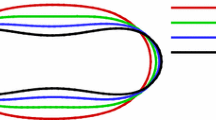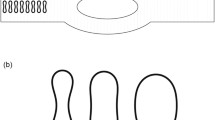Abstract
One of the major functions of the cardiovascular system is to deliver blood to the microcirculation where exchange of mass and energy can take place. In the present article, we will provide an overview of the state-of-the-art computational methods for modeling of red blood cell (RBC) rheology and dynamics in the microcirculation. While significant progress has been made in simulation of single-file motion of deformable RBCs in capillaries and of diluted sheared suspensions of RBCs in infinite domains, detailed understanding of the mechanics of blood flow in intermediate diameter microvessels (8–1000μm) has presented formidable challenges. The difficulties are largely due to modeling the motion of multiple, interacting, highly deformable particles. The current computational tools consist mainly of three-dimensional (3D) boundary-integral methods for single RBC dynamics and deformation; and for rheology of large systems of droplets at large volume fractions using periodic boundary conditions and novel adaptive computational meshes. Further advances will result from combination of these tools to produce new algorithms capable of describing the motion and deformation of large systems of RBCs in microvessels at physiologically relevant volume fractions.
Similar content being viewed by others
References
Aidun, C. K., and E.-J. Ding. Direct numerical simulation of red blood cell flow and scaling relation for the aggregate size distribution. In: International Biofluid Mechanics Conference, California Institute of Technology, December 12–14, 2003.
Barthes-Biesel, D., and H. Sgaier. Role of membrane viscosity in the orientation and deformation of a spherical capsule suspended in shear flow. J. Fluid Mech. 160:119–135, 1985.
Bugliarello, G., and J. Sevilla. Velocity distribution and other characteristics of steady and pulsatile blood flow in fine glass tubes. Biorheology 7:85–107, 1970.
Cokelet, G. R., and H. L. Goldsmith. Decreased hydrodynamic resistance in the two-phase flow of blood through small vertical tubes at low flow rates. Circ. Res. 68:1–17, 1991.
Coulliette, C., and C. Pozrikidis. Motion of an array of drops through a cylindrical tube. J. Fluid Mech. 358:1–28, 1998.
Cristini, V. Adaptive multiscale numerical simulation of blood rheology and red cell dynamics in the microcirculation. In: International Biofluid Mechanics Conference, California Institute of Technology, December 12–14, 2003.
Cristini, V., J. Blawzdziewicz, and M. Loewenberg. An adaptive mesh algorithm for evolving surfaces: Simulations of drop breakup and coalescence. J. Comp. Phys. 168:445–463, 2001.
Cristini, V., J. Blawzdziewicz, and M. Loewenberg. Drop breakup in three-dimensional viscous flows. Phys. Fluids 10:1781–1783, 1998.
Cristini, V., J. Blawzdziewicz, M. Loewenberg, and L. R. Collins. Breakup in stochastic Stokes flows: Sub-Kolmogorov drops in isotropic turbulence. J. Fluid Mech. 492:231, 2003.
Cristini, V., and J. Lowengrub. Three-dimensional crystal growth-II: Nonlinear simulation and suppression of the Mullins–Sekerka instability. J. Cryst. Growth 266:552, 2004.
Cristini, V., S. Guido, A. Alfani, J. Blawzdziewicz, and M. Loewenberg. Drop breakup and fragment size distribution in shear flow. J. Rheol. 47:1283, 2003.
Dintenfass, L. Inversion of the Fahraeus–Lindquist phenomena in blood through capillaries of diminishing radius. Nature 215:1099–1100, 1967.
Eggleton, C. D., and A. S. Popel. Large deformation of red blood cell ghosts in a simple shear flow. Phys. Fluids 10:1834–1845, 1998.
Evans, E. A., and R. Skalak. Mechanics and Thermodynamics of Biomembranes. CRC Press, Boca Raton, 1980.
Fahraeus, R., and T. Lindqvist. The viscosity of blood in narrow capillary tubes. Am. J. Physiol. 96:562–568, 1931.
Fung, Y. C. Stochastic flow in capillary blood vessels. Microvasc. Res. 5:34–49, 1973.
Goldsmith, H. L. Red cell motions and wall interactions in tube flow. Fed. Proc. 30:1578–1590, 1971.
Keller, S. R., and R. Skalak. Motion of a tank-treading ellipsoidal particle in a shear flow. J. Fluid Mech. 120:27–47, 1982.
Kennedy, M., C. Pozrikidis, and R. Skalak. Motion and deformation of liquid drops, and the rheology of dilute emulsions in shear flow. Comput. Fluids 23:251–278, 1994.
Li, X., J. Lowengrub, Q. Nie, V. Cristini, and P. Leo. Microstructure evolution in three-dimensional inhomogeneous elastic media. Met. Mater. Trans. A-Physica 34:1421, 2003.
Loewenberg, M., and E. J. Hinch. Numerical simulation of a concentrated emulsion in shear flow. J. Fluid Mech. 321:395–419, 1996.
Patel, P. D., E. S. G. Shaqfeh, J. E. Butler, V. Cristini, J. Blawzdziewicz, and M. Loewenberg. Drop breakup in the flow through fixed fiber beds: An experimental and computational investigation. Phys. Fluids 15:1146–1157, 2003.
Pozrikidis, C. Numerical simulation of the flow-induced deformation of red blood cells. Ann. Biomed. Eng. 31:1194, 2003.
Pozrikidis, C. ed. Modeling and Simulation of Capsules and Biological Cells. CRC Mathematical Biology and Medicine Series, Chapman& Hall, Boca Raton, 2003.
Pozrikidis, C. Dynamical simulation of the flow of suspensions: Wall-bounded and pressure-driven channel flow. Ind. Eng. Chem. Res. 41:6312–6322, 2002.
Pozrikidis, C. Effect of bending stiffness on the deformation of liquid capsules in simple shear flow. J. Fluid Mech. 440:269–291, 2001.
Pries, A. R., D. Neuhaus, and P. Gaehtgens. Blood viscosity in tube flow: dependence on diameter and hematocrit. Am. J. Physiol. 263:H1770–H1778, 1992.
Pries, A. R., K. Ley, and P. Gaehtgens. Generalization of the Fahraeus principle for microvessel networks. Am. J. Physiol. 251:H1324–H1332, 1986.
Reinke, W., P. Gaehtgens, and P. C. Johnson. Blood viscosity in small tubes: Effect of shear rate, aggregation, and sedimentation. Am. J. Physiol. 253:H540–H547, 1987.
Schmid-Schonbein, G. W., R. Skalak, S. Usami, and S. Chien. Cell distribution in capillary networks. Microvasc. Res. 19:18–44, 1980.
Secomb, T. W. Mechanics of red blood cells and blood flow in narrow tubes. In: C. Pozrikidis, ed. Modeling and Simulation of Capsules and Biological Cells. CRC Mathematical Biology and Medicine Series, Chapman& Hall, Boca Raton, 2003, pp. 163–190.
Secomb, T. W., S. Chien, K. M. Jan, and R. Skalak. The bulk rheology of close-packed red blood cells in shear flow. Biorheol. 20:295–309, 1983.
Secomb, T. W., T. M. Fischer, and R. Skalak. The motion of close-packed red blood cells in shear flow. Biorheol. 20:283–294, 1983.
Yen, R. T., and Y. C. Fung. Inversion of Fahraeus effect and effect of mainstream flow on capillary hematocrit. J. Appl. Physiol. 42:578–586, 1977.
Zheng X., S. Wise, and V. Cristini. Nonlinear simulation of tumor necrosis, neo-vascularization and tissue invasion via an adaptive finite-element/level-set method. Bull. Math. Biol. 67:211–259, 2005.
Zhou H., and C. Pozrikidis. Deformation of liquid capsules with incompressible interfaces in simple shear flow. J. Fluid Mech. 283:175–200, 1995.
Zinchenko A. Z., and R. H. Davis. Shear flow of highly concentrated emulsions of deformable drops by numerical simulations. J. Fluid Mech. 455:21–62, 2002.
Author information
Authors and Affiliations
Corresponding author
Rights and permissions
About this article
Cite this article
Cristini, V., Kassab, G.S. Computer Modeling of Red Blood Cell Rheology in the Microcirculation: A Brief Overview. Ann Biomed Eng 33, 1724–1727 (2005). https://doi.org/10.1007/s10439-005-8776-y
Received:
Accepted:
Issue Date:
DOI: https://doi.org/10.1007/s10439-005-8776-y




